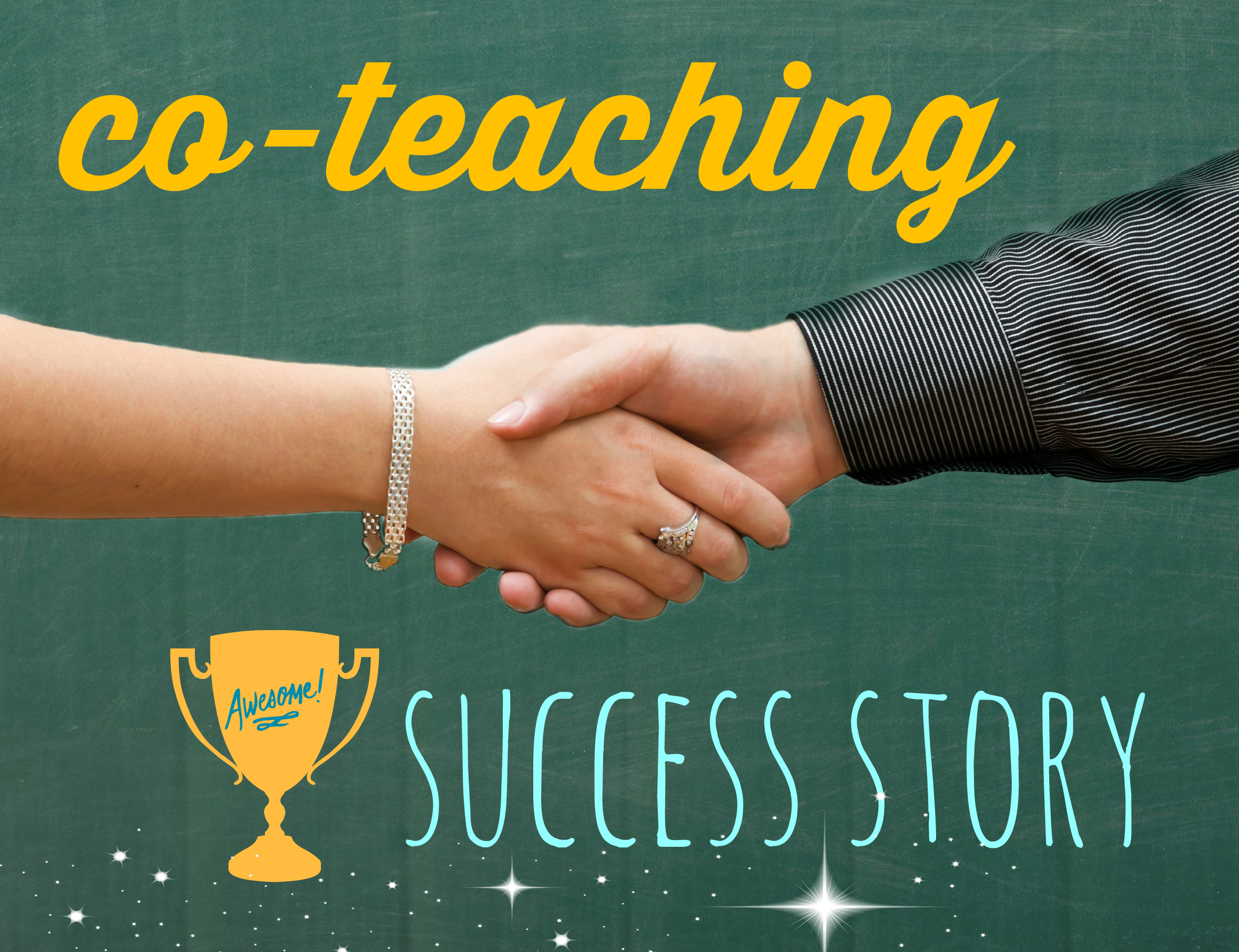A Deeper Look into Co-Teaching Success: Guest Post by Elizabeth Stein
February 25, 2016
Today I’m so pleased to welcome a special guest to the blog: instructional coach Elizabeth Stein, who is the creator of #coteachat and co-creator of #udlchat on Twitter. Elizabeth stops by today to bring you a different kind of co-teaching success story—one that’s completely honest about the challenges you might encounter when a co-teacher puts up “invisible cement walls” between you. Her story is a testament to the power of persistence and optimism, and I think you’ll enjoy her candor and the practical tips she shares from her personal experience.
Over to you, Elizabeth!
***
I could easily share an all-around happy-go-lucky successful co-teaching experience with you–but I won’t. We all know what the traditional success story looks like. Two teachers who just make it work together, no matter what. It’s the kind of success where two teachers have the respect, the ongoing communication, and the shared compassion to sustain positive learning experiences throughout the year. Those lucky students see what learning looks like and they know what successful learning feels like by participating in class every day.
When I reflect through my experiences to select one co-teaching success story, my mind naturally sifts through all recent and past inspirational and uplifting experiences. Of course many specific stories come to mind, and yet I keep returning to the experiences that were completely challenging and daunting. I keep returning to the stories that may not seem like a success at first glance. The process of sifting through to identify just one success story brought me to the awareness that each co-teaching experience has been a success. No kidding! How is that even possible, you ask?
It has become second nature for me to apply a more real-world, reframed definition of what success actually means. Typically, we think of a successful co-teaching experience as the one where students achieve and teachers co-plan, work together with parity, and collaborate in a respectful, consistent manner. I just keep thinking, Where does that leave all of the other realistic experiences? I just cannot think about all those memories as unsuccessful. My most challenging co-teaching experiences were, in fact, some of the most successful co-teaching experiences I encountered. Seriously! I learned so much about myself, all students, and my colleagues, and most important, I tapped into the ultra-innovative side of myself–the side that pushed through challenges to make sure students could have the opportunity to achieve to the best of their abilities. Through these challenging co-teaching successes, I learned how tenacious I am–and how, when I keep what is right for students as my guiding light, I can make any co-teaching experience a success.
My Story
I recall four students in this inclusive setting who were reading between three and four years below grade level. Yet, they were expected to come to class and engage in the learning. One of the students had a significant decoding weakness. The others read with strong decoding and fluency that far outpaced their ability to comprehend. They became anxious and withdrawn anytime comprehension was needed. And as you know, comprehension was needed most of the time!
My co-teacher and I had co-planning time (what a gift!). But don’t get too excited, because here’s what that looked like. This co-teacher would say, “Here are my plans” as the plan book was pushed across the table to me. I was then expected to either Xerox the pages or jot down what I needed. What a glorious choice! As for the instructional process, classtime consisted of us either taking turns or my co-teacher creating the territorial ground that left an invisible triple-layered cement wall between us. Any ideas I shared for incorporating strategies to guide each learner in the room, was met with the usual “This is the way I’ve always done it” or “We don’t really have time for that.” I felt like an uninvited, unwelcomed guest.
So how is this possibly a success story, you wonder? Because here’s how I addressed it:
- I planted seeds of Universal Design for Learning.
- I continued to share ideas for strategies to include in the process of learning–like modeling Cornell Note Taking.
- I provided extra help to students before school, after school, and during their lunch period. The one student who had a significant decoding weakness came to me before school for explicit instruction with decoding and fluency.
- I connected with students and parents through email to provide additional homework help as needed.
- I did not wallow in frustration (at least never for too long!). I rechanneled all energy into doing what I could do for my students–and creating a relationship to whatever extent possible with my co-teacher.
- I balanced my contributions with my co-teacher’s unwillingness to collaborate. I shared ideas and then stepped back to see where the ideas would go. And in time, the co-teacher came around. Not in a perfect-world kind of way, but in a “let’s do all we can–together–for our students” kind of way.
Okay, I won’t lie. It was exhausting to have to spend time and energy knocking down invisible cement walls that were rebuilt by my co-teacher on a regular basis. But I pushed through this challenge. I focused on the positive aspects of my co-teacher and the situation. My bottom-line question each morning was, What can I do for and with my students today? And at the end of the day, What did our students accomplish today? What worked well? What did not–and what can I do to follow up?
I was always aware that I was an advocate for students. My voice and actions needed to guide students to strengthen their voice and actions. For example, they learned to embrace their personal gains. They stopped putting a strong emphasis on comparing their grades to those of their peers. They began to focus clearly on their personal commitments to learning–and this led to the start of closing personal achievement gaps.
Here are three tips on how to make any co-teaching experience a positive one:
1. Practice Resilience
Develop a relationship with your co-teacher. Practicing resilience is easy when co-teachers share a philosophy and are open-minded educators who enjoy sharing teaching space. If your co-teacher isn’t the true collaborative type, that’s fine, because you will always model collaborative, respectful, ongoing, problem-solving, solution-seeking views. This approach will either be contagious or assuage any nay-saying co-teaching partner. Resilience will empower you to stay on the track of positive learning and teaching–and giving the all students in your class all you’ve got!
2. Model the power of positivity
For resilience to take root, we need to experience positive emotions. And we are in charge of that! When we are mindful to exercise positive thoughts, we engage in the world with a positive outlook. Research supports that when we fill our thoughts with positive emotions, we see more possibilities and opportunities. Just think about how this can translate into any co-teaching situation.
3. Strive for collaboration and collective resilience
There’s something to be said for never giving up. Embrace whatever the co-teaching situation is and always strive for shared solution-seeking conversations. Regardless of the personality or philosophical differences, you must come together for the students. If the relationship is seemingly beyond hope, return to how you view the situation. Focus on the positive aspects. Work directly with the students if a co-teaching partner is standoffish. You will be amazed at the success that unfolds!
***
Thanks to Elizabeth for being here today and sharing her tips for co-teaching success. She leaves us with these questions: How do you define success? And how do you make it a part of all of your co-teaching stories? Add your thoughts in the comments below!




Write a Comment
Your email address will not be published. Required fields are marked *
Post a Comment